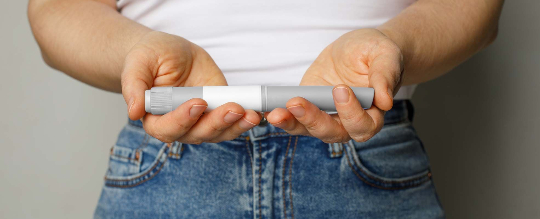Many men notice at some point in life that their shirt is tight around the stomach, workouts don’t go as smoothly as before, and morning spontaneous erections have become less frequent. It’s often thought to be just about “extra pounds” or age.
In reality, the fat accumulating around the midsection is like a small factory that produces inflammation, disrupts sugar metabolism, and interferes with hormonal balance – and its effects are visible in energy levels, mood, sexual desire, and erection.
Why is Abdominal Fat Specifically a Problem?
The fat that accumulates inside the abdominal cavity, around the organs, is active tissue. It sends messages to the body that impair its ability to use sugar as fuel and accelerate low-grade inflammation. At the same time, the fatty tissue converts some of the man’s own testosterone into estrogen.
Over time, this lowers testosterone levels, which in turn reduces muscle mass and energy expenditure. The vicious cycle is complete: the less muscle and vitality, the easier it is for the waistline to grow – and the larger the waist, the harder it is to maintain hormonal balance.
What Does this Look like in Everyday Life?
A typical story starts with small signs: afternoon fatigue, slow recovery after workouts, decreased interest in things and lack of productivity, and constant hunger or cravings for sweets. The waistline tightens first by a few centimeters, then a bit more.
At the same time, sexual desire may decrease and erections may feel less reliable. Many also experience disrupted sleep – snoring increases and there’s a congested feeling in the morning. When sleep becomes fragmented, hunger hormones get confused and choices easily lean towards “quick fixes”. The result is visible in the mirror and in how one feels.
“but the Blood Tests Were within Normal Range”
A familiar phrase at the doctor’s office. Based on the numbers, everything may appear “ok” or individual changes are small and the overall picture is overlooked: blood sugar is just barely within the reference range, cholesterol is moderate, and testosterone fits within the reference range. Yet, how one feels tells a different story.
It’s important to understand that many changes happen quietly in the background and manifest as symptoms before laboratory limits are exceeded. That’s why mapping symptoms, measuring waist circumference, and listening to sleep and energy levels are just as important as measured values.
Sexual Health Reflects the Entire Body
Erection is a sensitive indicator of vascular and nervous system health. As abdominal fat increases and sugar metabolism falters, the inner lining of arteries becomes irritated and blood flow decreases. This may first be noticeable in the bedroom, even if the ECG is still normal.
The good news: when weight decreases and sleep stabilizes, sexual health often improves within just a few months. Many men are surprised at how quickly desire and confidence return when the basics are put in order.
Can Testosterone Therapy Solve Everything?
For some, testosterone replacement therapy is necessary and, when correctly chosen, beneficial. But if the root cause of the problem is central obesity or untreated sleep apnea, hormone therapy alone won’t fix the underlying issue.
Think of it this way: testosterone is like motor oil: it reduces friction and makes the engine run smoother. If the tires are flat and the brakes are dragging (i.e., sleep, nutrition, and daily activity are in disarray), oil alone won’t get you to your destination. That’s why the overall picture matters.
Where to Start – a Sensible, Effective Plan for Men
1. Measure and observe.
Waist circumference is a surprisingly honest indicator. When it decreases, many other things improve. Also listen to your mornings: do you feel rested, is there spontaneous erection, is the day energetic?
2. Make eating easy.
Include a clear protein source in every meal (fish, chicken, meat, eggs, quark, plant proteins). Protein protects muscle and keeps hunger better in check. Add fiber and colorful vegetables to your plate. You don’t need to fear carbohydrates either – timing and amount in relation to physical activity are more important than tricks.
3. Make strength training a routine.
Two or three short, intense strength training sessions per week are enough to maintain muscle mass and strength, which is the body’s best “fat-burning machine”. Workouts don’t need to be long or perfect. Consistency beats sophistication.
4. Clean up your sleep.
A regular bedtime, a cool bedroom, and reducing smart device use in the evenings help surprisingly much. If you snore or have breathing pauses, it’s worth investigating sleep apnea – treating it can quickly change your quality of life.
5. Consider aids wisely.
Current medications for weight management can be an excellent support. They don’t replace food and movement, but they can quiet the constant hunger signal and facilitate a change in direction.
In some cases, the body’s hunger signals are so severely confused that weight loss simply doesn’t succeed without medication. It’s not just about willpower but biology.
The Goal is not a “Summer Body” but Operational Power
When a man’s body functions well, everyday life is simply better: the mind is sharp, the feeling is light, and the desire for life – including in the bedroom – returns. Weight loss doesn’t need to be rapid. Even small, steady progress goes a long way when muscle is maintained and daily life runs smoothly. Often, a 5-10 percent reduction from the starting weight is sufficient.
Frequently Asked Questions – Direct and Clear
“Can Reducing Waist Size Really Increase Testosterone?”
Yes, this has been demonstrated in scientific studies. When abdominal fat decreases, body inflammation subsides and the brakes on hormone function ease. For many, morning vitality and desire return within months.
“Do I Always Need Medication for Weight Loss?”
Not necessarily. Some manage with lifestyle changes alone, some benefit from medication, and for others, it’s almost essential. The most important thing is to find a model that suits you and that you can maintain.
“My Erection is Failing – where Do I Start?”
Start with the basics: sleep, blood pressure, waist. If you’re older and have risk factors for vascular disease, erectile dysfunction can be the first sign of arterial blockage.
In this case, it’s good to have the situation assessed by a competent doctor, so that the next organ to fail isn’t the heart or brain. At the same time, erectile medication can be considered, but the most important thing is to treat the root cause, in which case the situation can be permanently corrected and the progression of the disease process can also be stopped.
“What if I’m Already on the Better Side of Fifty?”
Age doesn’t prevent results. Good sleep, smart eating, regular training, and medication if needed work regardless of age. The goal is functionality and quality of life, not just the scale.
When to See a Doctor?
If your waist has crept over 100 centimeters, if mornings are consistently sluggish, if desire or erection is concerning you, or if you just don’t feel like yourself – then it’s worth contacting Painoklinikka’s experts.
At the appointment, we’ll look at the big picture: sugar balance, fat values, sleep, and hormones if necessary. You’ll get a clear, practical plan that fits your daily life. No guilt-tripping – just steps that work.
Book an appointment and start your return to a strong, alert, and desiring body. When the foundation is in order, a man feels good – and it shows in everything you do
Vilho Ahola
Weight Management Physician












